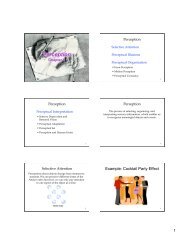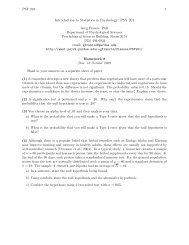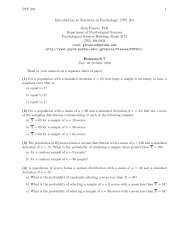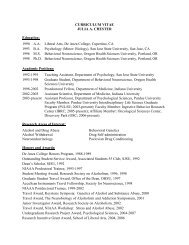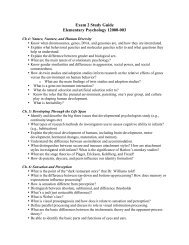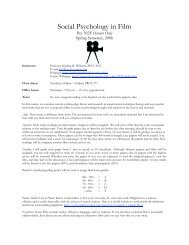Maxims or Myths of Beauty? A Meta-Analytic and Theoretical Review
Maxims or Myths of Beauty? A Meta-Analytic and Theoretical Review
Maxims or Myths of Beauty? A Meta-Analytic and Theoretical Review
Create successful ePaper yourself
Turn your PDF publications into a flip-book with our unique Google optimized e-Paper software.
effects <strong>of</strong> attractiveness. Although there are many empirical stud-<br />
ies about the imp<strong>or</strong>tance <strong>of</strong> attractiveness f<strong>or</strong> children (see, e.g.,<br />
Dion, 1974; Hildebr<strong>and</strong>t & Fitzgerald, 1978; Langlois & Stephan,<br />
1977), ours is the first meta-analysis to include them in a compre-<br />
hensive analysis.<br />
Method<br />
Retrieval <strong>of</strong> Studies<br />
We began by examining the adult <strong>and</strong> child attractiveness literature<br />
obtained from APA databases (PsycLIT, PsycINFO), Cash's (1981) anno-<br />
tated bibliography, <strong>and</strong> the ERIC database <strong>of</strong> published, unpublished, <strong>and</strong><br />
conference papers using key terms beauty, facial attractiveness, <strong>and</strong> phys-<br />
ical attractiveness. We also examined every relevant article from the<br />
reference sections <strong>of</strong> all retrieved articles. This search resulted in obtaining<br />
references from 1932 through June 1999.<br />
Because there are many f<strong>or</strong>ms <strong>of</strong> attractiveness <strong>and</strong> our primary interest<br />
was in objectively rated facial attractiveness within the n<strong>or</strong>mal distribution,<br />
we excluded studies in which the face was not available f<strong>or</strong> assessment<br />
(body attractiveness, e.g., Singh, 1993; vocal attractiveness, e.g., Zucker-<br />
man & Driver, 1989; grooming, e.g., Mack & Rainey, 1990) <strong>or</strong> if the study<br />
instructed judges to evaluate a different type <strong>of</strong> attractiveness (sexual<br />
attractiveness, e.g., Townsend & Wasserman, 1997; self-evaluations <strong>of</strong><br />
attractiveness, e.g., N. Cavi<strong>or</strong> & Dokecki, 1971), if the study measured<br />
another variable such as popularity but labeled the variable as attractive-<br />
ness (e.g., Krantz, 1987), if the study confounded attractiveness with other<br />
variables (e.g., targets were selected to be both attractive <strong>and</strong> high in<br />
self-monit<strong>or</strong>ing, Snyder et al., 1985), <strong>or</strong> if the study compared facially<br />
disfigured targets to nondisfigured targets (e.g., Field & Vega-Lahr, 1984).<br />
Because we wanted to underst<strong>and</strong> the role <strong>of</strong> attractiveness in actual<br />
interactions, we excluded studies if they were pure attribution experiments<br />
(i.e., a study in which behavi<strong>or</strong>al, trait, <strong>or</strong> personality attributions are made<br />
only by strangers <strong>and</strong> based solely on a photograph as per the studies<br />
included in Eagly et al., 1991), if they failed to rep<strong>or</strong>t useable statistics; if<br />
the unit <strong>of</strong> analysis was m<strong>or</strong>e than a single individual (e.g., if dyads were<br />
analyzed together, Clark & Ayers, 1988), if variables were curvilinear <strong>and</strong><br />
it was not clear that either extreme was positive <strong>or</strong> negative, <strong>or</strong> if we could<br />
not place the variable into a meaningful categ<strong>or</strong>y (e.g., there was only one<br />
study <strong>of</strong> child self-perceived traits, Leruer, Delaney, Hess, Jovanovic &<br />
von Eye, 1990).<br />
From an initial sample <strong>of</strong> over 1,800 empirical articles, we obtained a<br />
final data set <strong>of</strong> 919 useable effect sizes with some studies contributing<br />
m<strong>or</strong>e than one independent sample. To control f<strong>or</strong> the possibility that our<br />
analysis overestimated the effect <strong>of</strong> attractiveness by excluding studies we<br />
did not retrieve (i.e., the file-drawer problem, Rosenthal, 1979), we com-<br />
puted the fail-safe n f<strong>or</strong> each analysis (Hedges & Olkin, 1985). This<br />
statistic determines the number <strong>of</strong> additional nonsignificant effect sizes<br />
necessary to reduce the effect sizes we rep<strong>or</strong>t to null differences between<br />
attractive <strong>and</strong> unattractive groups. The results <strong>of</strong> these fail-safe analyses<br />
indicate how resistant the findings are to the file-drawer problem <strong>and</strong><br />
highlight which results, if any, should be interpreted with caution.<br />
Description <strong>of</strong> <strong>and</strong> Assignment to Categ<strong>or</strong>ies<br />
The three maxims provided the initial conceptual basis f<strong>or</strong> our catego-<br />
rization <strong>of</strong> effect sizes. We examined five overall categ<strong>or</strong>ies f<strong>or</strong> adults <strong>and</strong><br />
four overall categ<strong>or</strong>ies f<strong>or</strong> children: reliability <strong>of</strong> attractiveness ratings,<br />
judgment, treatment, behavi<strong>or</strong>/traits, <strong>and</strong> (f<strong>or</strong> adults only) self-perceptions.<br />
Within each <strong>of</strong> these categ<strong>or</strong>ies, we created subcateg<strong>or</strong>ies by grouping<br />
conceptually similar variables. Whenever possible, we constructed parallel<br />
subeateg<strong>or</strong>ies f<strong>or</strong> adults <strong>and</strong> children, but <strong>of</strong>ten the dependent variables<br />
examined f<strong>or</strong> children did not c<strong>or</strong>respond to those investigated f<strong>or</strong> adults.<br />
MAXIMS OR MYTHS OF BEAUTY 395<br />
Reliability<br />
All reliability coefficients <strong>of</strong> attractiveness ratings from retrieved studies<br />
were analyzed. The vast maj<strong>or</strong>ity <strong>of</strong> these studies asked raters to evaluate<br />
attractiveness from photographs (generally these raters were not the same<br />
participants analyzed f<strong>or</strong> judgment <strong>or</strong> treatment); the remaining studies<br />
asked raters to evaluate attractiveness in situ <strong>or</strong> from videotapes. In almost<br />
all cases, judges used either a Likert-type scale <strong>or</strong> rank <strong>or</strong>ders to evaluate .<br />
attractiveness.<br />
We were interested in whether children would evaluate attractiveness<br />
similarly to adults, whether raters <strong>of</strong> different ethni¢ity would evaluate<br />
attractiveness similarly when residing in similar cultures with similar<br />
exposure to media st<strong>and</strong>ards <strong>of</strong> beauty, <strong>and</strong> whether raters <strong>of</strong> different<br />
ethnicity within different cultures <strong>and</strong> presumably different media expo-<br />
sure would evaluate attractiveness similarly. Thus, four analyses were<br />
perf<strong>or</strong>med to evaluate: (a) Adult within-culture, within-ethnic agreement,<br />
including only studies in which adults residing in the same culture were<br />
rated by others <strong>of</strong> the same ethnicity as the targets; (b) child within-culture,<br />
within-ethnic agreement, including only studies in which children residing<br />
in the same culture were rated by others <strong>of</strong> the same ethnicity as the targets;<br />
(c) adult within-culture, cross-ethnic agreement, in which c<strong>or</strong>relations<br />
among raters residing within the same culture but from different ethnic<br />
groups were analyzed (e.g., African Americans judging European Ameri-<br />
cans); <strong>and</strong> (d) adult cross-cultural, cross-ethnic agreement, in which c<strong>or</strong>-<br />
relations among raters residing in different countries <strong>and</strong> from different<br />
ethnic groups were analyzed (e.g., K<strong>or</strong>eans judging African Americans).<br />
We located insufficient numbers <strong>of</strong> studies <strong>of</strong> children from different<br />
ethnic groups from either their own <strong>or</strong> other cultures, precluding analyzing<br />
cross-ethnic reliability f<strong>or</strong> children. See Appendix A f<strong>or</strong> inf<strong>or</strong>mation about<br />
studies included in the meta-analyses <strong>of</strong> cross-cultural <strong>and</strong> cross-ethnic<br />
agreement <strong>and</strong> Appendix B f<strong>or</strong> studies included in the within-culture,<br />
within-ethnic analyses.<br />
Judgment <strong>and</strong> Treatment<br />
Assignment <strong>of</strong> effect sizes to both this set <strong>of</strong> analyses <strong>and</strong> to the<br />
behavi<strong>or</strong>/traits analyses was m<strong>or</strong>e complex than assignment to our reliabil-<br />
ity analyses because <strong>of</strong> the diversity <strong>of</strong> research measures found in re-<br />
trieved studies. The studies retrieved f<strong>or</strong> judgment, treatment <strong>and</strong> behavi<strong>or</strong>/<br />
traits used st<strong>and</strong>ardized <strong>and</strong> unst<strong>and</strong>ardized measures, global <strong>and</strong><br />
moleculal" measures, ratings by experts <strong>and</strong> nonexperts, <strong>and</strong> self- versus<br />
other-rep<strong>or</strong>ts <strong>of</strong> behavi<strong>or</strong>s, traits, <strong>and</strong> treatments. Separating different types<br />
<strong>of</strong> measures that seemingly assessed the same construct but in fact had<br />
significantly different conceptual foundations was necessary to success-<br />
fully differentiate measures <strong>of</strong> judgment, treatment, <strong>and</strong> behavi<strong>or</strong>. F<strong>or</strong><br />
example, friendliness could be assessed by global judgments made casually<br />
by a rater <strong>or</strong> by molecular behavi<strong>or</strong>al counts <strong>of</strong> smiling made by a highly<br />
trained observer. Although both may have been construed as indexes <strong>of</strong> the<br />
construct "friendliness" in different studies, these two measures have<br />
imp<strong>or</strong>tant conceptual differences. Distinguishing between global <strong>and</strong> mo-<br />
lecular measures is crucial because global ratings <strong>and</strong> judgments <strong>of</strong> indi-<br />
viduals can be influenced by the "beauty is good" stereotype: Global<br />
ratings <strong>of</strong> friendliness reflect opinions <strong>of</strong> the rater as much as, if not m<strong>or</strong>e<br />
than, they reflect the behavi<strong>or</strong> <strong>of</strong> the target (Ritter & Langlois, 1988).<br />
Theref<strong>or</strong>e, we assigned global measures to the judgment categ<strong>or</strong>y. In<br />
contrast, molecular measures c<strong>or</strong>respond closely to actual behavi<strong>or</strong>s (Ritter<br />
& Langlois, 1988) <strong>and</strong> thus were assigned to behavi<strong>or</strong>/traits. Descriptions<br />
<strong>of</strong> the particular types <strong>of</strong> measures included in each categ<strong>or</strong>y created f<strong>or</strong><br />
judgments, treatment, <strong>and</strong> behavi<strong>or</strong>/traits are provided below.<br />
Judgment. This categ<strong>or</strong>y was conceptualized as inf<strong>or</strong>med opinions<br />
about attractive <strong>and</strong> unattractive targets. The categ<strong>or</strong>y <strong>of</strong> judgment was<br />
thus defined as global ratings (e.g., friendliness, intelligence) made by<br />
others based on actual incidents <strong>of</strong> observable behavi<strong>or</strong>.<br />
Studies investigating judgments about children typically consisted <strong>of</strong><br />
peer <strong>and</strong> adult ratings <strong>of</strong> behavi<strong>or</strong>al traits <strong>and</strong> personality characteristics.


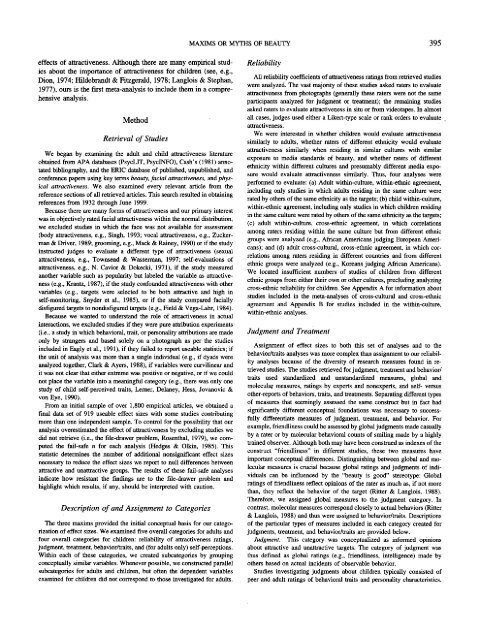


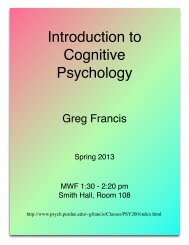
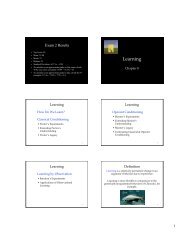
![Exam 4 Study Guide[1]](https://img.yumpu.com/45196739/1/190x245/exam-4-study-guide1.jpg?quality=85)
